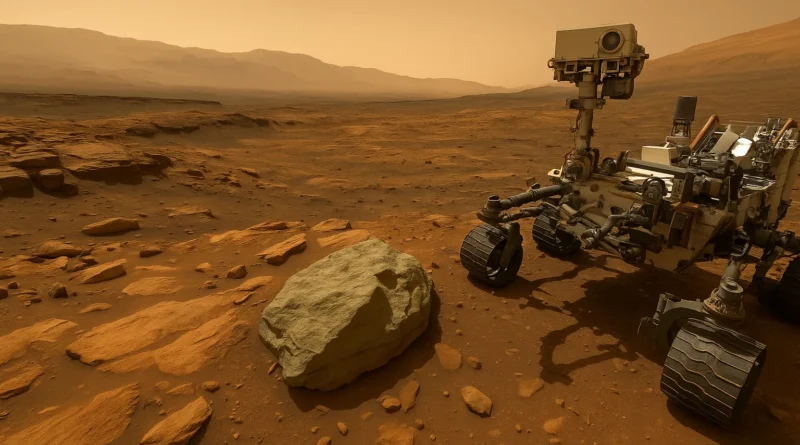Curiosity Rover Uncovers Ancient Carbon Cycle on Mars, Suggesting Past Habitability
Curiosity Rover Finds Clues to Ancient Carbon Cycle on Mars
NASA’s Curiosity rover has made a groundbreaking discovery in Gale Crater on Mars: the presence of iron carbonate minerals, specifically siderite, in rock samples. This finding provides compelling evidence that Mars once had a carbon cycle similar to Earth’s, suggesting a thicker atmosphere and the presence of liquid water—conditions that could have supported life.
Siderite Discovery Points to Past Atmospheric Conditions
Between 2022 and 2023, Curiosity drilled into sedimentary rocks in Gale Crater, uncovering siderite concentrations up to 10.5% by weight. Siderite forms in environments rich in carbon dioxide and water, indicating that ancient Mars had a denser atmosphere capable of sustaining liquid water on its surface.
“The presence of siderite suggests that Mars had a carbon cycle involving the atmosphere, water, and rocks,” said Dr. Benjamin Tutolo, lead author of the study published in Science. “This cycle is crucial for understanding the planet’s past climate and its potential to support life.
Implications for Mars’ Climate History
The discovery of siderite helps explain the long-standing mystery of Mars’ missing carbon. While scientists have observed dried riverbeds and lakebeds, indicating the past presence of water, previous missions struggled to find carbonate minerals that would confirm a thicker atmosphere. The new findings suggest that significant amounts of carbon dioxide were sequestered into the Martian crust, altering the planet’s climate over time.
This sequestration could have led to a decrease in greenhouse gases, causing Mars to cool and lose its ability to support liquid water. Understanding this process is vital for reconstructing the planet’s climatic evolution and assessing its habitability.
Comparisons with Earth’s Carbon Cycle
On Earth, the carbon cycle is balanced by processes like plate tectonics and biological activity, which recycle carbon between the atmosphere, oceans, and crust. Mars, however, lacks plate tectonics and shows no definitive signs of life, leading to an imbalanced carbon cycle. The discovery of siderite indicates that Mars’ carbon was locked away in rocks, reducing atmospheric carbon dioxide and contributing to the planet’s cooling.
“Mars’ carbon cycle appears to have been one-way, with carbon dioxide being removed from the atmosphere and stored in the crust,” explained Dr. Tutolo. “This contrasts with Earth’s dynamic system, where carbon is continuously cycled.”
Potential for Past Life
The interaction between the atmosphere, water, and rocks on ancient Mars suggests that the planet may have had conditions suitable for life. The presence of liquid water and a thicker atmosphere could have created a habitable environment for microbial organisms. While no direct evidence of life has been found, the discovery of siderite adds to the growing body of evidence that Mars was once more Earth-like.
Future missions, including the planned Mars Sample Return mission, aim to bring Martian rocks back to Earth for detailed analysis. These studies could provide further insights into Mars’ geological history and its potential to have supported life.
Conclusion
The Curiosity rover’s discovery of siderite in Gale Crater marks a significant advancement in our understanding of Mars’ past. The findings indicate that the planet once had a carbon cycle involving a thicker atmosphere and liquid water, creating conditions that could have supported life. This discovery not only sheds light on Mars’ climatic history but also guides future explorations in the search for signs of past life on the Red Planet.
Category: Space Exploration
References
-
“NASA rover finds fresh evidence of the warm and wet past of Mars” – ReutersGizmodo+2Reuters+2NASA+2
-
“Curiosity rover reveals ancient carbon cycle on Mars” – AOLAOL+1The Times of India+1
-
“Rover finds hints of an ancient Martian carbon cycle” – Ars TechnicaArs Technica
Note: This post was created with the help of AI, and all the data used was collected from reliable websites.


